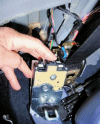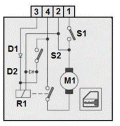
B-Post Actuator
The actuator (motorised striker) on the B post

This is mounted on the B post and the loop moves SIDEWAYS to pull the door in at the back. This is the first/last movement when the door opens/closes.
To see if the actuator is set properly, close the door and check the door is flush with the body after being pulled in. A slight smear of grease on the actuator loop will aid initial disengagement of the latch.

On mine, the driver's B-post actuator was starting to get a bit wheezy - so rather than fit a new actuator right away, I squirted a little silicone spray into it. Inspection of my spare actuator shows that it is mounted so the motor and gearing are BELOW the two mounting screw holes. Part #'s are: Driver's (right): 9164.65 and Passenger (left): 9164.66
So - by removing the lower T40 Torx screw, I could spray a little silicone spray in - which hopefully would drop down into the moving bits.
In practice it seems to have done exactly that, and it lasted another 7 years until it slowed again - so I replaced it as below.
To replace the actuator on the B post Information courtesy of Marinus van der Leest

Open the door.
After switching off the ignition, wait 3 minutes before disconnecting the battery.

When the door is closing, the last action is to pull in the door at the rear. The locking unit (hook in the B-post) pulls in the door and sends a signal to the control unit: "door is closed".
In this unit, in addition to a small electric motor, there are a pair of switches operated by cams on an internal shaft; these are sealed in and not serviceable. As the cars age, these contacts are beginning to go high resistance and/or fail which can be difficult to diagnose and cause intermittent door problems.
How to remove:

With the help of a plastic or wooden wedge the plastic cover at the bottom of the door opening can be lifted. For the four special clips, it is just a matter of prising up. BUT BE CAREFUL with the front clip as excessive force can break the moulded-in clips.

Sometimes the white blocks stay behind but they easily can be removed with a flat screwdriver and slid back in the cover.

Next remove 2 x Torx (T40) bolts (items 2 on the drawing above) holding the actuator from the B post.
Take care, the unit is still located at the bottom by a hook to the body of the car. If a second-hand unit, sometimes these hooks are broken off; they are not essential as the 2 torx bolts are all that is necessary to hold the actuator in correct position.

Using your hand from underneath you can unclip the fixing on the bottom of the unit (you can just see it) and then the unit can be taken out.

Reassemble and finally check the door is flush with the bodywork when closed.
When finally replacing the cover, note that the hard plastic of the cover fits OVER the rubber seal (you might expect it to fit under - but it doesn't).

Sealed in the B-post actuator there are some contacts which gives the exact position of the actuator. These contacts can sometimes fail intermittently but can't be accessed to clean up.

Mystery when the B-post actuator seems to work in reverse: it has been found that the actuator can push OUT when the door is closing but pull IN when the door should be opening.
The B-post actuator should send a signal to the ECU when it is fully pushed out or fully pulled in; if these signals are lost then the ECU won't know what to do - so it could be a faulty connection anywhere - or just temporarily confused electronics! Sometimes a new actuator is fitted and works fine, but still can't be certain that was where the fault was.







